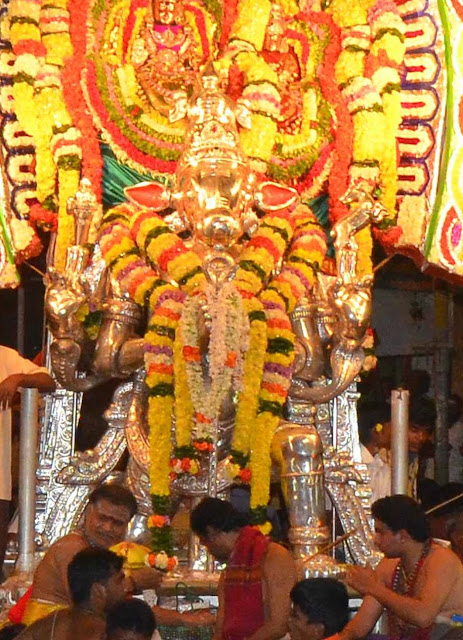On the Morning of Day Two of the Karthigai Deepam Festival, the mount of Lord Arunachaleswarar is the Surya Perai Vahanam (also known as Vaghanam).
 |
| Lovely Rukku getting her procession exercise |
During each procession the Gods are seated on their respective Vahana. The word “Vahana” denotes “that which carries, that which pulls” and signifies the mount of the God. These mounts represent a Divine attribute associated with the God.
 |
| Lord Arunachaleswarar on Surya Vahana at Alankaram Mandapam |
The deity may be seen sitting or standing on the vahana. Alternatively the Deity may be sitting on a small platform called a “howdah”, or riding on a saddle or bareback. Positive aspects of the vahana are often emblematic of the Deity that it carries. However, the vehicle animal can also symbolise the evil forces over which the deity dominates.
 |
| God's Darshan 2nd Day Morning |
The Surya Vahana in the morning of Day Two of the Karthigai Festival, is the representation of Fire (or Agni) as the fourth element of the Panchabhutas. The essential character of Fire is to generate heat and according to Hindu Mythology, Agni is one of the Eight Guardians that guard our Universe and are known as Asta-dik-palakas.
 |
| Circumambulation of the Mada Veedhis |
In Indian mythology there are mentions of various types of fires. The four important ones are fire of the earth, fire of the sky, fire of the stomach (can mean hunger and digestive power as well) and the fire we commonly use.
 |
| Lord Arunachaleswarar on Surya Perai Vahanam |
There is a wealth of mythology attached to Arunachala connected to its association with fire and what is related to fire i.e. light and the sun. To read more go to this link here.


















































